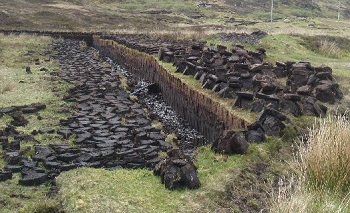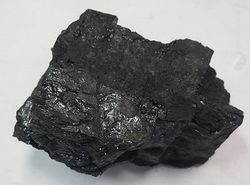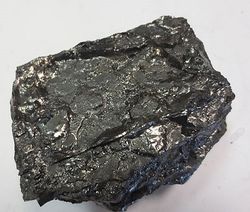Coal types
Different coal types are all minerals and rocks made largely of carbon. This fossil fuel generates ~40% of the world's electricity and about 25% of the world's primary energy. However, not all coal used is the same; it comes in different quantity levels of carbon—which dictates the quality of the coal. Higher quality coal produces less smoke, burns longer, and provides more energy than lower quality coal.
The table below includes the carbon contents, and energy densities of coal. In addition, it states the moisture content before drying, and the amount of volatile content, after it's dried.
| Coal | Dry, Carbon content (%) | Moisture content before drying (%) | Dry, volatile content (%) | Heat Content (MJ/kg) |
|---|---|---|---|---|
| Anthracite | 86-92 | 7-10 | 3-14 | 32-33 |
| Bituminous coal | 76-86 | 8-18 | 14-46 | 23-33 |
| Sub-Bituminous coal | 70-76 | 18-38 | 42-53 | 18-23 |
| Lignite | 65-70 | 35-55 | 53-63 | 17-18 |
| Peat | <60 | 75 | 63-69 | 15 |
The following is an overview of the different grades of coal, ordered from lowest to highest quality. Please see their main pages to learn more about each type.
Peat

Peat is a soft, crumbly, dark brown substance that is formed from generations of dead and partially decaying organic matter. Peat is the first step in the formation of coal, and slowly becomes lignite after pressure and temperature increase as sediment is piled on top of the partially decaying organic matter. In order to be turned into coal, the peat must be buried from 4-10 km deep by sediment.[3] Peat exhibits the lowest carbon content (less than 60%) and has an energy density of 15 MJ/kg[4]
Lignite

Lignite or brown coal is brown in colour and the lowest quality of coal. The carbon content of lignite ranges from 65-70%,[4] therefore, compared to other types of coal it contains the greatest amount of compounds other than carbon—such as sulfur and mercury.[6] Lignite is the youngest fossil fuel produced, with an age of approximately 60 million years. Its relatively short lifespan means it exhibits quite a low energy density at 18 MJ/kg.[4] Lignite's high moisture content and lower carbon content results in more carbon dioxide emissions than harder black coals.
Sub-Bituminous

Sub-bituminous coal or black lignite is a grey-black or dark brown coal. It ranges from hard to soft as it represents an intermediate stage between low quality lignite and higher quality bituminous coal. The carbon content of sub-bituminous coal varies from 70-76%.[8] Sub-bituminous coals are among the younger coals geologically—approximately 251 million years old. Therefore, the longer burial time compared to lignite increases it's energy density ranges from 18-23 MJ/kg.[4] This type of coal is the most commonly used, with 30% of coal resources being sub-bituminous.[9]
Bituminous

Bituminous coal is the second highest quality of coal, with a carbon content that ranges from 76-86%.[11] It is the most abundant type, and one of the longest buried fossil fuels—with an age of approximately 300 million years old. Therefore, its energy density is relatively high at 27 MJ/kg.[4] The high carbon and low moisture content of this particular type of coal makes it ideal in the production of steel and cement, as well as in electricity generation and coke production.[12]
Anthracite

Anthracite is a dark black form of coal and the highest quality coal. It is very hard, has a low moisture content, and a carbon content of nearly 95%.[14] When burned, anthracite can reach a very high temperature. In addition, anthracite is usually the oldest type of coal, having formed from biomass that was buried 350 million years ago. Its prolonged burial time means it exhibits a very high energy density of 33 MJ/kg—the highest of any type of coal.[4] Since so much energy is released when burned, this fuel is exceptional at heating up quickly and burning very hot.[15] Anthracite is used for space heating as it is one of the cleanest types of coal to burn—producing less smoke than other types. Its clean burning properties allows anthracite to burn longer than wood, making it appealing to use in home heating stoves.[16]
For Further Reading
- Coal
- Carbon
- Carbon cycle
- Fossil fuel formation
- World electricity generation
- Or explore a random page
References
- ↑ This table is taken almost exactly from Chapter 2 of P. Breeze, Coal-fired Generation. Academic Press, 2015.
- ↑ Wikimedia Commons. (May 13, 2015). Peat Cuttings [Online]. Available: http://commons.wikimedia.org/wiki/File:Peat_cuttings_near_Unasary_-_geograph.org.uk_-_176303.jpg#/media/File:Peat_cuttings_near_Unasary_-_geograph.org.uk_-_176303.jpg
- ↑ Stephen Marshak. (May 13, 2015). Earth: Portrait of a Planet, 3rd ed. New York, NY, U.S.A:W.W. Norton & Company, 2008
- ↑ 4.0 4.1 4.2 4.3 4.4 4.5 P. Breeze, Coal-Fired Generation. Elsevier Science, 2015.
- ↑ Wikimedia Commons. (May 13, 2015). Lignite [Online]. Available: http://commons.wikimedia.org/wiki/File:Lignite_Klingenberg.jpg
- ↑ R. Wolfson. Energy, Environment and Climate, 2nd ed. New York, U.S.A.: Norton, 2012, pp. 95-96
- ↑ James St. John. (May 13, 2015). Lignite Coal. Available: https://www.flickr.com/photos/jsjgeology/8512397381/
- ↑ J. Kraushaar, R. Ristinen. (May 13, 2015). Energy and the Environment, 2nd ed. Hoboken, NJ, U.S.A.: John Wiley & Sons, 2006
- ↑ Wendy Lyons Sunshine. (May 13, 2015). Sub-Bituminous Coal [Online]. Available: http://energy.about.com/od/Coal/a/Sub-Bituminous-Coal.htm
- ↑ Wikimedia Commons. (May 13, 2015). Bituminous Coal [Online]. Available:http://commons.wikimedia.org/wiki/File:Bituminous_Coal.JPG
- ↑ J. Kraushaar, R. Ristinen. (May 11, 2015).Energy and the Environment, 2nd ed. Hoboken, NJ, U.S.A.: John Wiley & Sons, 2006
- ↑ Canadian Federation of Earth Sciences. (May 11, 2015). Four Billion Years and Counting: Canada's Geological Heritage, 1st ed. Toronto, ON, Canada.: Nimbus Publishing, 2014
- ↑ Wikimedia Commons. (May 13, 2015). Anthracite Coal [Online]. Available: http://commons.wikimedia.org/wiki/File:Anthracite_Coal.JPG
- ↑ J. Kraushaar, R. Ristinen. (May 11, 2015). Energy and the Environment, 2nd ed. Hoboken, NJ, U.S.A.: John Wiley & Sons, 2006, pp. 50
- ↑ Stephen Marshak. (May 13, 2015). Earth: Portrait of a Planet, 3rd ed. New York, NY, U.S.A:W.W. Norton & Company, 2008
- ↑ Wendy Lyons Sunshine. (May 13, 2015). Anthracite Coal [Online]. Available: http://energy.about.com/od/Coal/a/Anthracite-Coal.htm

